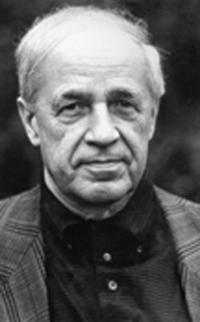|
|
Pierre Boulez
Gavin Thomas introduces the work of Pierre Boulez (1925–).
Overview
Composer, conductor, theorist, visionary: Pierre Boulez has been many
things to many people.
To some he is quite simply the
single most significant classical musician of the past fifty years; to others, he’s
a superannuated modernist whose natural gifts have been stifled
by his constant need to intellectualize and pontificate.
Whatever one’s attitude, Boulez’s pervasive influence on
today’s musical culture – from avant-garde
compositional theory to the concert repertoire of the world’s major symphony
orchestras – is virtually impossible to ignore.
Born in southeastern France in 1925, Boulez studied composition with Messiaen in
Paris before bursting into spectacular compositional life in the late 1940s with
a sequence of remarkably accomplished pieces such as the first two
piano sonatas and the cantatas Le visage nuptial and Le soleil des eaux –
works which at once summarize and surpass all that
was then most modern in music.
Repudiating all the compromises with tradition which, he
claimed, marred the work even of composers as progressive as Schoenberg and Stravinsky,
Boulez set about creating a brave new musical world, untouched
by sentiment or retrospection – as in the fearlessly complex
and nerve-janglingly dissonant Piano Sonata no. 2, which expresses
an exuberance bordering almost on rage, making
clear Boulez’s determination, not so much to wipe the slate clean as to smash it to bits.
Thus established as the enfant terrible of French music,
Boulez embarked on a period of research into ways
of writing music that would eradicate all traces of tradition, an
enterprise he shared with other young iconoclasts such as Stockhausen and Nono
– the so-called “Darmstadt School”, named after the German town
which hosted a summer school devoted to their ideals.
It was Messiaen’s uncharacteristically austere
Mode de valeurs et d’intensités which showed
how, by systematically ordering pitch, rhythm and dynamics in strict
numerical sequences, one could write “automatic” music.
And it was Boulez who produced, in Structures I for two pianos, the
classic work of what has come to be known as “total serialism”: music
(in its first movement at least) of absolute abstraction and pure process.
Boulez, the figurehead of the hyper-modernist cause, continued to
promulgate the doctrine loudly in his many writings and pronouncements.
Nevertheless, his next major work, Le marteau sans maître,
was remarkable more for its pure love of musical colour
and its fascinatingly incantatory melodic lines than for any
theoretical advances, as was the still grander work
for voice and ensemble which followed, Pli selon pli.
As the 1950s and 1960s progressed,
Boulez’s effortless creative confidence seemed to evaporate, though
there was no slackening in his protean intellectual speculations.
He flirted with electronics in Poésie pour pouvoir, with
open-ended form in Figures, doubles, prismes,
and with indeterminacy in the Piano Sonata No. 3 –
all accompanied by self-justificatory essays, and all subsequently withdrawn,
revised or left unfinished.
It was at this time that Boulez emerged as
a conductor of international standing – perhaps finding in
conducting a surrogate outlet for his increasingly
stifled compositional urges.
By 1970 he was holding prestigious but onerous positions as
chief conductor of both the BBC Symphony Orchestra and
the New York Philharmonic, and the compositions had virtually dried up.
The uncharacteristically sombre orchestral work Rituel was the
only finished work to emerge during the entire 1970s, and the remainder
of his diminishing compositional output consisted not of
fresh projects, but of revisions and recompositions of earlier
pieces (Boulez has made a constant and confusing habit
of constantly revising certain of his pieces, of
issuing them in radically different versions, or sometimes simply leaving
them “unfinished” for indefinite periods).
Then, in 1977, came the greatest public challenge
of Boulez’s career, when he secured a colossal
grant from the French government for the establishment of
the Institut de Recherche et Co-ordination Acoustique/Musique (IRCAM)
, a futuristic musical laboratory buried under the Pompidou Centre
in the heart of Paris.
Overseen by Boulez, IRCAM was to provide a hi-tech
venue in which leading composers and scientists would work together
to investigate the possibilities of technology in music, educating musicians
and public in a set-up complete with its
own resident ensemble, the peerless Ensemble InterContemporain.
In the history of music only Wagner previously had been
able to command patronage on this scale, and
expectations were high, the greatest one being that
Boulez himself would use the resources of IRCAM to produce the
masterpiece which seemed to be demanded by investment on such a massive scale.
Boulez’s response, Répons, premiered in 1981,
rose magnificently to the challenge of producing a huge
public statement using the latest computerized gadgetry and represented a high-water
mark in his career as a composer.
Répons was to be Boulez’s (as yet) last major original
undertaking using the IRCAM set-up, although he has continued
to work intermittently with computer music in a
series of smaller works, most notably, . . . explosante-fixe . . . ,
for flute and chamber ensemble (this being the latest
reworking of a piece that, in characteristically Boulezian fashion, now
exists in no less than four different versions).
Other works of the past two decades have included exquisite miniatures such
as Dérive and Memoriale and
further revisions and recompositions of earlier works (notably
a refulgent new version of Le visage nuptial)
which have made clear just how far Boulez’s earlier
theoretical postures were at variance with his natural musical
leanings towards the sumptuous, the sensuous and the quintessentially French.
Even so, despite this increasing shedding of creative
inhibitions, Boulez’s seeming inability since the massive
undertaking of Répons to tackle fresh major
projects suggests, sadly, that one of the
great inspirational sources of twentieth-century music has finally run out of steam.
Article and review pages originally published in The Rough Guide
to Classical Music
|